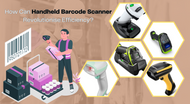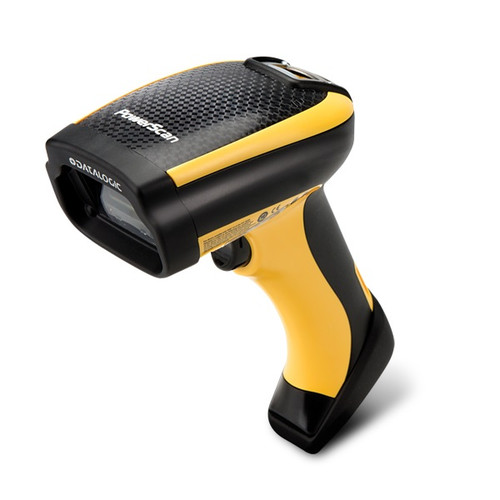How Can Handheld Barcode Scanner Revolutionise Efficiency?
In today’s business world,the need to find innovative solutions to streamline processes has become paramount. With the pace at which industries are advancing, organisations are recognising the importance of optimising their workflows to stay competitive and meet the demands of a rapidly changing market. One such innovation that has emerged as a cornerstone in this quest for efficiency is the barcode scanner. These handheld devices play a pivotal role in simplifying and accelerating various business processes. By automating tasks such as inventory management, point-of-sale transactions, and asset tracking, barcode scanners not only enhance the speed and accuracy of operations but also contribute to the overall agility of businesses. In a world where time is of the essence, the significance of barcode scanners lies in their ability to reduce manual errors, improve data visibility, and ultimately pave the way for more streamlined and effective business operations. Embracing such technologies becomes not just a choice but a necessity for organisations aspiring to thrive in the dynamic landscape of the 21st century.
In this blog post, we will explore how handheld barcode scanners are transforming the way businesses operate and enhancing overall productivity.
Let’s start by discussing-
What are Barcode Scanners?
Barcode scanners are electronic devices designed to read and decode information encoded in barcodes. Barcodes, consisting of parallel lines and spaces of varying widths, serve as a visual representation of data that can be quickly and accurately scanned by these devices. The primary purpose of barcode scanners is to automate data entry processes, eliminating the need for manual input and minimising the risk of human error. These scanners use a light source and a photosensitive element to capture the pattern of the barcode, converting it into digital data that can be interpreted by a computer or other electronic systems. Widely employed in various industries, from retail and logistics to healthcare and manufacturing, barcode scanners enhance efficiency by rapidly and precisely capturing information embedded in barcodes. Their versatility and ease of use make them indispensable tools for tasks such as inventory management, point-of-sale transactions, and asset tracking, contributing significantly to the overall optimisation of business processes.
What are Handheld Barcode Scanners?
Handheld barcode scanners, also known as portable or mobile barcode scanners, have become ubiquitous tools in various industries for streamlining data capture processes. These devices have a fascinating history and have evolved significantly since their inception.
History and Evolution
The concept of barcodes dates back to the 1940s, but it wasn't until the 1970s that the first barcode system was implemented commercially. The first barcode, a simple linear design, was scanned on a pack of Wrigley's chewing gum in 1974. This marked the beginning of a transformative era in inventory management and retail.
The early barcode scanners were large and fixed-mount devices. However, the need for mobility and flexibility led to the invention of the first handheld barcode scanner. In 1981, Symbol Technologies (now part of Zebra Technologies) introduced the Symbol LS2208, a lightweight handheld scanner that could read one-dimensional barcodes. This innovation marked a crucial milestone in the history of barcode technology, enabling users to scan barcodes without being tethered to a fixed location.
As technology advanced, handheld barcode scanners evolved to incorporate laser scanning technology, offering improved speed and accuracy. The use of CCD (Charged Coupled Device) sensors also became prevalent, allowing for the capture of high-quality barcode images. These technological advancements enhanced the versatility of handheld scanners, enabling them to read various barcode symbologies.
In the 1990s and early 2000s, 2D imaging technology emerged, allowing handheld scanners to read not only traditional linear barcodes but also two-dimensional barcodes and QR codes. This expanded the range of applications for handheld scanners, making them invaluable in industries such as healthcare, logistics, and manufacturing.
The 21st century witnessed another significant leap with the introduction of wireless handheld barcode scanners. Bluetooth technology enabled scanners to communicate wirelessly with computers and other devices, providing users with greater flexibility and mobility. Cordless scanners became particularly popular in retail environments, streamlining point-of-sale operations.
To meet the demands of challenging environments, ruggedised handheld barcode scanners were developed. These devices were designed to withstand harsh conditions, such as those in warehouses or manufacturing plants. Additionally, handheld scanners were customised for specific industries, such as healthcare, where hygiene and durability are critical considerations.
With the widespread use of smartphones and tablets, handheld barcode scanners began integrating with these devices. Mobile applications allow users to leverage the camera on their smartphones as a barcode scanner, further expanding the accessibility and utility of barcode technology.
In recent years, advancements in artificial intelligence and machine learning have been integrated into handheld barcode scanners, enhancing their capabilities for data processing and analysis. This evolution continues to drive efficiency and productivity across various industries.
Features of Handheld Barcode Scanners
Handheld barcode scanners are versatile devices designed to read and decode barcodes efficiently. These devices come with a range of features that make them essential tools in various industries.
Here are some key features of handheld barcode scanners:
- Portability: Handheld barcode scanners are compact and lightweight, allowing users to easily carry them around. This portability makes them ideal for applications where mobility is essential, such as retail, warehouses, and field service.
- Wireless Connectivity: Many handheld scanners come with wireless connectivity options like Bluetooth or Wi-Fi. This enables seamless integration with other devices like smartphones, tablets, or computers, providing flexibility in data transfer and management.
- Scan Engine Technology: The scan engine is a critical component of barcode scanners. There are different technologies, including laser, CCD (Charge-Coupled Device), and 2D imaging. Laser scanners are suitable for linear barcodes, while 2D imaging scanners can read both linear and 2D barcodes.
- Decoding Capabilities: Handheld barcode scanners can decode various types of barcodes, including 1D (linear) barcodes like UPC and EAN, as well as 2D barcodes like QR codes and Data Matrix codes. This versatility makes them suitable for a wide range of applications.
- Durability: Since handheld barcode scanners are often used in industrial environments, they are built to withstand rough handling and environmental conditions. They may be designed to resist dust, water, and drops to ensure reliable performance in challenging settings.
- Trigger or Continuous Scanning: Handheld scanners typically feature a trigger button that users can press to activate the scanning process. Some models also offer continuous scanning, where the scanner can capture multiple barcodes in rapid succession without the need for repeated triggering.
- Compatibility: These scanners are designed to be compatible with various operating systems, making it easy to integrate them with different devices and software platforms. This compatibility enhances their usability in diverse business environments.
- Battery Life: Many handheld scanners are battery-powered, and the battery life is a crucial factor, especially in situations where the device is used continuously throughout the day. Longer battery life reduces the frequency of recharging or changing batteries.
- Display and User Interface: Some handheld scanners come with built-in displays and user interfaces, allowing users to view scanned data, check battery status, and access configuration settings directly on the device.
- Data Storage and Transfer: Handheld scanners often have the capability to store scanned data internally or transfer it in real-time to a connected device. This feature ensures that data is captured and processed efficiently, reducing the risk of information loss.
Role of Handheld Barcode Scanners in Enhancing Business Efficiency
Handheld barcode scanners have played a transformative role in the way businesses operate, significantly enhancing overall productivity across various industries.
Here's how they contribute to this transformation:
- Efficient Inventory Management: Handheld barcode scanners streamline inventory management by allowing quick and accurate tracking of stock levels. Businesses can easily scan barcodes to update inventory databases, reducing the likelihood of errors associated with manual data entry. This efficiency minimises stockouts, overstock situations, and helps in maintaining optimal inventory levels.
- Faster and Accurate Data Capture: Traditional manual data entry is prone to errors, and it can be time-consuming. Handheld barcode scanners enable rapid and accurate data capture by simply scanning barcodes. This not only reduces human errors but also accelerates the data entry process, leading to improved efficiency and data accuracy.
- Enhanced Point of Sale (POS) Operations: In the retail sector, handheld barcode scanners expedite the checkout process. Cashiers can quickly scan product barcodes, reducing waiting times for customers. This not only enhances the customer experience but also allows businesses to process transactions more swiftly, leading to increased customer satisfaction and higher sales throughput.
- Real-time Data Access: The wireless capabilities of handheld scanners, such as Bluetooth or Wi-Fi, enable real-time data transfer to connected devices. This ensures that information is instantly updated in centralised databases, providing businesses with up-to-the-minute insights into inventory levels, sales figures, and other critical data points.
- Error Reduction in Data Entry: Manual data entry is susceptible to errors, which can lead to costly mistakes in areas such as inventory management and order fulfilment. Handheld barcode scanners significantly reduce the risk of errors by automating the data capture process. This not only saves time but also enhances the overall accuracy of business data.
- Improved Traceability and Visibility: Barcode scanning facilitates better traceability of products throughout the supply chain. Businesses can track items from production to distribution and monitor their movement in real-time. This increased visibility helps in identifying bottlenecks, optimising processes, and ensuring the timely delivery of goods.
- Streamlined Asset Management: Businesses often have valuable assets that need to be tracked and managed efficiently. Handheld barcode scanners simplify asset management by allowing organisations to label and scan assets. This ensures that assets are accounted for, located easily, and maintained according to schedule, reducing the risk of loss or theft.
- Enhanced Productivity in Field Operations: In field service operations, handheld barcode scanners enable technicians to quickly identify and track equipment, access service histories, and update records on-site. This leads to faster issue resolution, improved customer satisfaction, and overall increased productivity in field service operations.
- Compliance and Regulatory Requirements: In industries with strict compliance and regulatory requirements, such as healthcare and pharmaceuticals, handheld barcode scanners assist in accurately tracking and documenting products. This ensures that businesses adhere to industry regulations and quality standards, reducing the risk of non-compliance issues.
- Adaptability to Various Industries: Handheld barcode scanners are versatile tools that can be adapted to various industries, including retail, healthcare, manufacturing, logistics, and more. Their flexibility in reading different types of barcodes and seamless integration with existing systems make them valuable assets for businesses across diverse sectors.
Wrapping Up,
The handheld barcode scanner is a powerful tool that has transformed the landscape of business efficiency. Its ability to provide speed, accuracy, and convenience has made it an invaluable asset across various industries. From inventory management to point-of-sale transactions, the impact of handheld barcode scanners is undeniable. As businesses continue to seek ways to enhance productivity and stay ahead in the competitive market, the adoption of handheld barcode scanners is a strategic move towards a more efficient and streamlined future.
If you are looking to buy the best handheld barcode scanner at an affordable price, look no further! POS Sales Australia is your one-stop shop for premium point of sale (POS) hardware, consumables, accessories, and bundles, all available at the best prices. Browse through our inventory of premium handheld barcode scanners and shop for the perfect device today!
Need assistance? Contact us or call our POS expert at 1300 026 062


